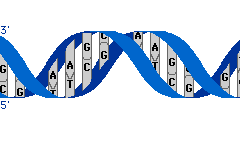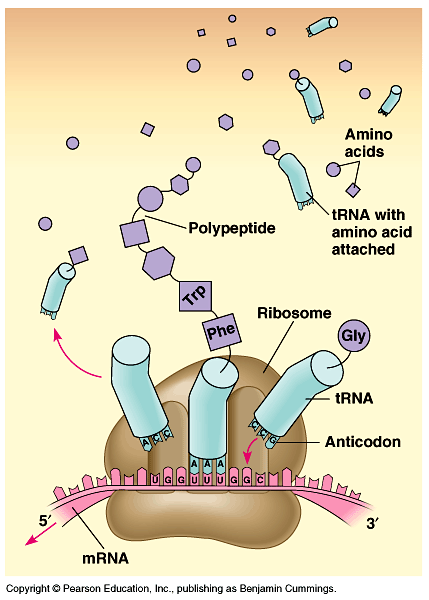|
Genes
-
The information in DNA is in the sequence of bases of the nucleotides.
-
The bases are the "letters" of the "words."
-
Only one strand of the DNA is used for information.
-
DNA words are three letters long (triplets): TACCAGGGCACATTC
-
One "sentence" is called a gene.
-
A gene has information for making one protein.
-
DNA has billions of nucleotides which make thousands of genes.
The central dogma of biology states that:
- The information of a gene is copied into an RNA molecule.
- The RNA contains the same information as the gene.
- The information of the RNA is used to build a protein.
- The protein performs a function for the cell.
|

Human DNA has approximately 25,000 to 35,000 genes.
Central Dogma: DNA ----> RNA ----> Protein

|
|
Transcription
- DNA ----> RNA
- in the nucleus
- by the enzyme RNA polymerase
Transcription: copying the information in a gene into an RNA molecule
- RNA polymerase, an enzyme, unzips the DNA at the beginning of a gene
- Free RNA nucleotides pair with complementary DNA nucleotides (A::U & C::G)
- RNA polymerase bonds the nucleotides together
- At the end of the gene, RNA polymerase releases the DNA and the new RNA molecule
Transcription animation

http://www.biologycorner.com/bio1/DNA.html
|
DNA ----(transcription)----> RNA ----(translation)----> Protein
Transcription diagram

http://biology12-lum.wikispaces.com/Transcription--Danis+Wang
|
|
Translation
- RNA ----> Protein
- in the cytoplasm
- by ribosomes
Translation: using mRNA information to build a protein.
- The mRNA reading frame has 3 nucleotide “words” called codons.
- Each codon codes for a specific amino acid or for starting or stopping translation.
- Ribosomes carry out the process of translation in the cytoplasm of the cell.
- The ribosome holds the mRNA and tRNA molecules.
- The tRNA anticodons match the mRNA codons by complementary base pairing.
- The amino acids on the tRNA molecules are bonded together by the ribosome.
- At the stop codon, the ribosome releases the mRNA and the new protein molecule.
The Genetic Code
- Each mRNA codon matches a specific tRNA anticodon.
- Each tRNA is bonded to a specific amino acid.
- The codons have the information for the specific amino acid sequence in the protein.
- Each gene has a unique sequence of nucleotides.
- Transcription makes a unique mRNA.
- Each mRNA codes for a specific protein.
- 1000s of genes produces 1000s of proteins that build and maintain cells and organisms.
This table shows the mRNA codons and the amino acids they code for during translation.
This is called the genetic code.
Each codon represents an amino acid.
There are 20 different amino acids.
The amino acid names are abbreviated, like Phe, Ser, Met, etc.

http://www.nature.com/scitable/content/the-genetic-code-6903567
How to use the genetic code
Look at the sequence of bases of the nucleotides of a gene of DNA.
Write the sequence of bases of the complementary RNA made by transcription.
Write the abbreviations of the amino acids in the protein made by translation.
gene = TAC AGG CTA GGG CTT ATA GCA ACA
mRNA = AUG UCC GAU CCC GAA UAU CGU UGU
protein = Met--Ser--Asp--Pro-Glu--Tyr--Arg [stop]
- Usually proteins are 100s or 1000s of amino acids in length.
- The structure and function of the protein is determined by the sequence of amino acids.
|
Translation

Another image of Translation

Transcription and Translation video
|
|
Assignment - Part I
Click Animations from The University of Utah
Click Tour the Basics
Click "What is DNA?"
Read the questions:
1. Where are the instructions for a cell?
2. What does DNA stand for?
3. What are the letters of the DNA alphabet?
4. How many letters are in a DNA word?
5. What are the "sentences" of DNA called?
6. The DNA "sentences" are instructions for making what molecule?
Watch the animation. Use the "Next" button to continue.
Write the questions and the answers in your notebook.
Click "What is a gene?"
Read the questions:
7. What are genes?
8. What are genes made of?
9. What are three examples of proteins in the animation?
Watch the animation. Use the "Next" button to continue.
Write the questions and the answers in your notebook.
Click "What is a protein?"
Read the questions:
10. Where are receptor proteins located on cells?
11. What do receptor proteins do?
12. What do structural proteins do?
13. What molecule has the information for making proteins?
14. What molecule carries the information - the message - from the nucleus to the cytoplasm?
15. What structure in the cytoplasm uses the message to build the protein?
16. How many proteins does a cell need?
Watch the animation. Use the "Next" button to continue.
Write the questions and the answers in your notebook.
|
Assignment - Part II
Click Animations from The University of Utah
Click DNA to Protein
Click Transcribe & Translate a Gene or the image
Click "Click Here To Begin"
Write the questions and the answers in your notebook.
17. What is the first thing that happened to the DNA?
(Refresh the page if you miss it)
Type the complementary bases for the transcribed RNA molecule.
18. What RNA base pairs with the DNA base "A"?
Move the mouse over the RNA strand. Move the green box over the AUG sequence.
19. AUG is the start codon. What amino acid corresponds to AUG?
(Use the genetic code to find AUG)
Move the green box over AUG, click on it.
Find the codon in the genetic code.
Find the three letter abbreviation for the amino acid next to the codon.
Click and drag the amino acid to the flashing box.
Repeat until you reach the stop codon.
20. List the names of the amino acids in the protein.
|
|
Mutation
Mutation is a change in the DNA code.
Gene mutations happen in a single gene.
- Point mutation is a change in a single nucleotide, like A is changed to C.
- Frameshift mutation is an insertion or deletion of a nucleotide which changes the reading frame.
Chromosomal mutations are large changes in chromosomes that affect many genes.
- Duplication and deletion happen during unequal crossing over causing one chromatid to have repeated genes and one chromatid to have missing genes.
- Translocation is the exchange of pieces of chromosomes between nonhomologous pairs which can cause duplications and deletions.
Mutations can have no effect (silent), a small effect, or a large effect.
- Mutations in noncoding regions or mutations that don’t change the amino acids in the proteins do not affect the phenotype.
- Point mutations may change one amino acid in the protein which could have a small or large affect on the function of the protein.
- Frameshift mutations usually have a large affect on the protein because many amino acids are changed.
- Chromosomal mutations always have a large affect on phenotypes because many genes are duplicated or deleted.
Only mutations that happen in sex cells are passed on to offspring; mutations in body cells are not passed on.
Mutations are caused by mistakes in DNA replication and by mutagens.
- Mutagens are things in the environment that cause mutations.
- Examples are UV radiation from sunlight, nuclear radiation, industrial chemicals, and natural chemicals like nicotine in tobacco.
|
Mutation Review Questions
- Compare gene mutations: point mutations and frameshift mutations - how are they similar and different?
- Which gene mutation has a larger effect, point mutation or frameshift mutation? Why?
- What is a chromosomal mutation?
- Which has a larger effect, gene mutation or chromosomal mutation? Why?
- What are the possible effects of a mutation?
- How does a point mutation affect transcription and translation?
- How does a frameshift mutation affect transcription and translation?
- Are all mutations in a parent passed on to an offspring?
- How are mutations passed on to offspring? (In what kind of cell do they have to occur?)
- What causes mutations?
|
|
Biotechnology WebQuest
http://www.iptv.org/exploremore/ge/default.cfm
Use this webpage to answer the questions: Explore More - Genetic Engineering
Write the questions and your answers in your notebook.
Click on "Uses"
1-3. Find three different ways that genetic engineering is used and describe them.
Click on "GE In-Depth" (Move you mouse over each picture to see how cloning happens)
4. What is recombinant DNA technology?
5-8. How are genes transferred? (4pts: all accurate. 3pts: one error. 2pts: several errors 1pt: partially accurate)
9-12. How was the first mammal, a sheep named Dolly, cloned? (4pts: all accurate. 3pts: one error. 2pts: several errors 1pt: partially accurate)
Click on "Search"
13. What is bioremediation?
14. How can genetic engineering be used to help people with genetic diseases?
|
Biotechnology Practice Quiz
|
Comments (4)
San said
at 4:18 pm on Feb 3, 2012
Mr. Sharp! Is cloning part of genetic engineering?
Darrell Sharp said
at 6:35 pm on Feb 3, 2012
Cloning is not part of genetic engineering.
Biotechnology includes both genetic engineering and cloning.
(Some people may include cloning with genetic engineering, but most people do not because the genes of the cloned organism haven't been changed.)
Katrina said
at 7:52 pm on Jun 5, 2012
mr. sharp! Point mutation and frameshif mutation. which one has larger effect and why?
Darrell Sharp said
at 10:20 pm on Jun 5, 2012
Frameshift mutations have larger effects because they change how the codons are read, so the whole protein is messed up and doesn't function. Point mutations only change one letter, so the protein isn't affected that much.
You don't have permission to comment on this page.